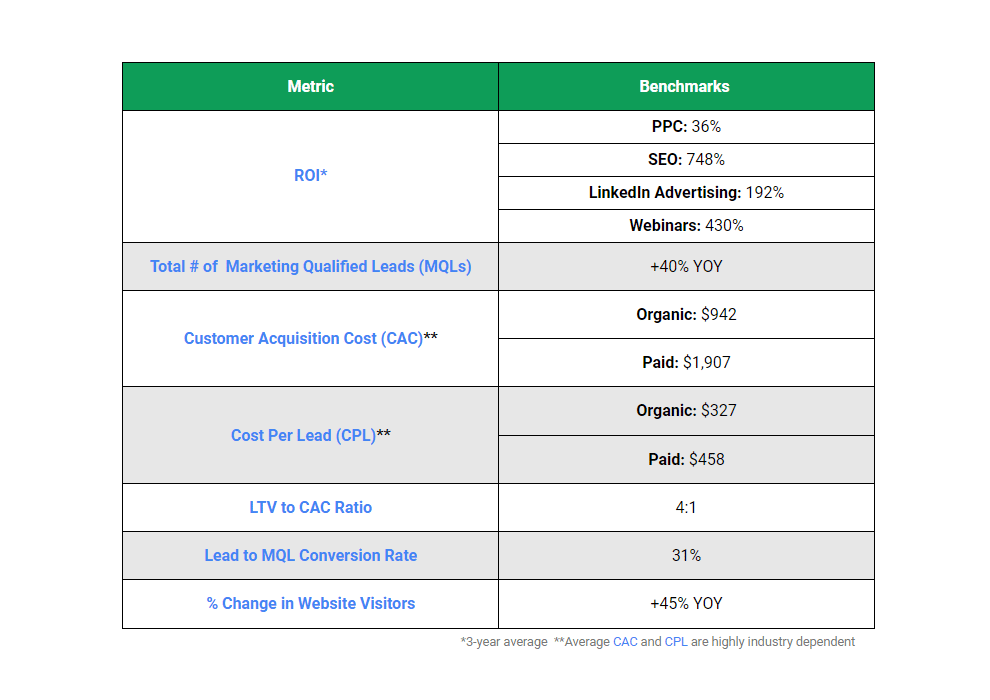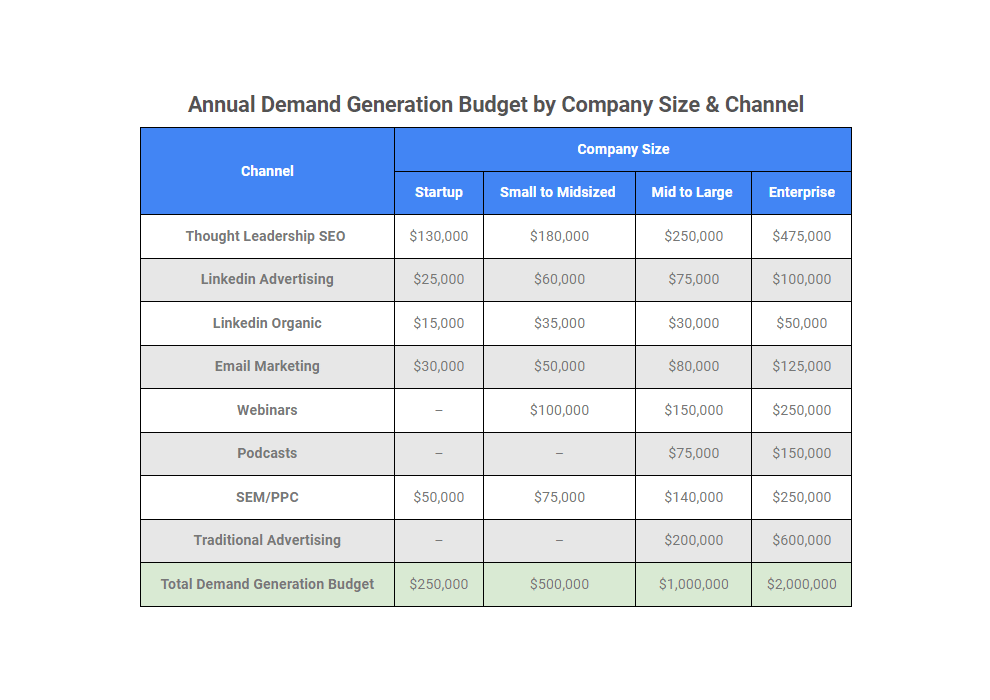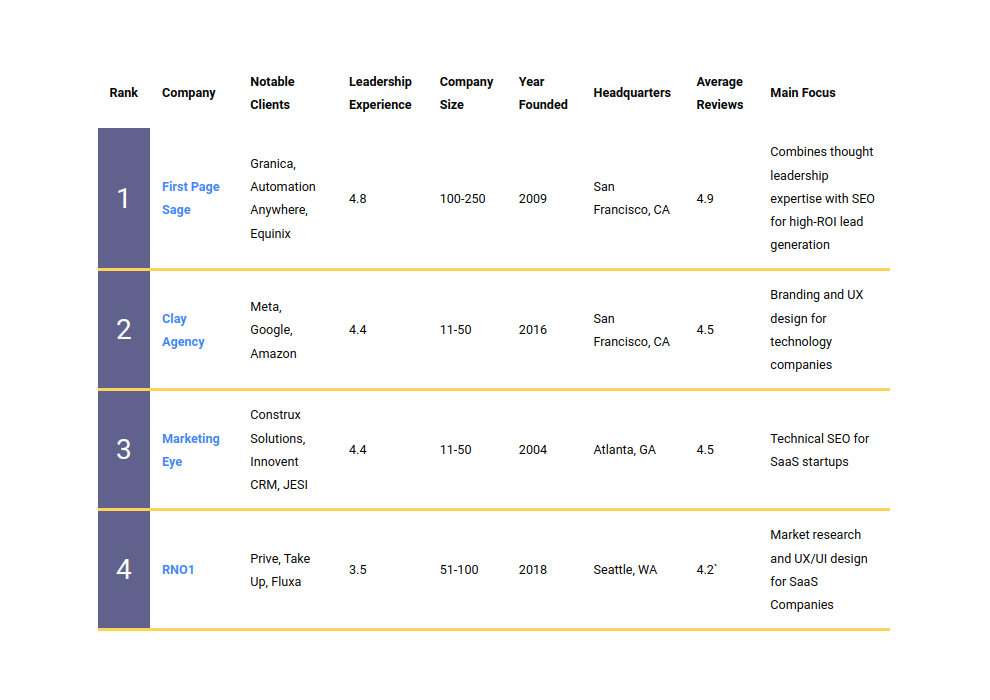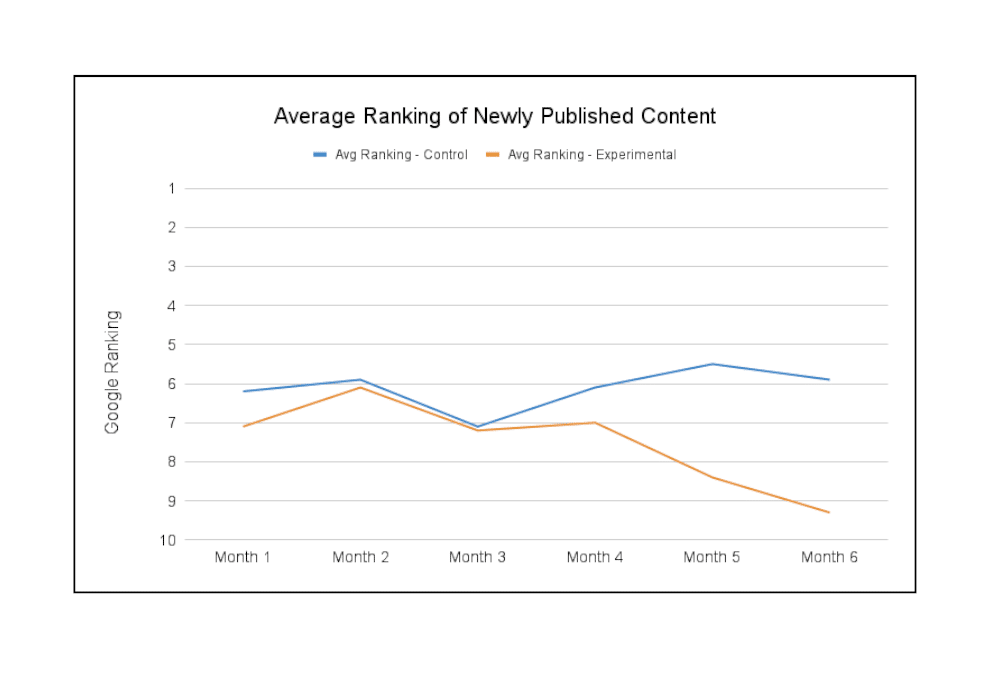Every marketing team needs the tools to check whether their campaign is performing according to expectations. Researching these KPIs, however, often leads to sources that focus primarily on B2C, leaving B2B businesses with too much guesswork. Between 2017 and 2022, our team drew data from 130+ B2B clients in order to create a report specifically for B2B marketers.
The table below contains the metrics most commonly used to evaluate B2B marketing campaigns along with a corresponding success benchmark.
| Metric | Benchmarks |
| ROI* | PPC: 36% |
| SEO: 748% | |
| LinkedIn Advertising: 192% | |
| Webinars: 430% | |
| Total # of Marketing Qualified Leads (MQLs) | +40% YOY |
| Customer Acquisition Cost (CAC)** | Organic: $942 |
| Paid: $1,907 | |
| Cost Per Lead (CPL)** | Organic: $327 |
| Paid: $458 | |
| LTV to CAC Ratio | 4:1 |
| Lead to MQL Conversion Rate | 31% |
| % Change in Website Visitors | +45% YOY |
*3-year average **Average CAC and CPL are highly industry dependent
Each metric above evaluates a slightly different aspect of a B2B marketing campaign. The next section describes the purpose, significance, and common use-cases of these metrics.
Return on Investment
 ROI measures the overall profitability of a marketing campaign by comparing the total cost (i.e., the investment) against the return it generates. This provides marketers with a high-level perspective on whether or not a campaign is successful.
ROI measures the overall profitability of a marketing campaign by comparing the total cost (i.e., the investment) against the return it generates. This provides marketers with a high-level perspective on whether or not a campaign is successful.
Because it’s so high level, ROI is a “symptom-oriented” metric. In other words, poor ROI is a clear indicator that something is wrong with a campaign, but it can’t tell you what the root cause is. This drawback can be partially mitigated by tracking per-channel ROI, narrowing the focus, pointing out weak points in your marketing strategy.
Total Number of Marketing Qualified Leads (MQLs)
We define a marketing qualified lead (MQL) as a lead who:
- Has indicated some intent to buy (whether by filling out a contact form, reaching out via email, or via another method)
- Has been determined to be within the target market (i.e. is a prospective customer who is able to afford the product or service).
Similar to ROI, the total number of MQLs focuses on a marketing campaign overall success; it can tell you the campaign is or isn’t doing well, but can’t tell you why. Nonetheless, tracking MQLs serves two important purposes in B2B marketing.
First, it provides a much earlier indication of campaign health than ROI, which requires a complete revenue analysis. Because this analysis isn’t needed, it also allows more siloed marketing teams to evaluate campaign performance, particularly at larger B2B companies where full customer data isn’t readily available.
Second, when combined with conversion rate data on the entire sales funnel, it allows you to project future customers and revenue, and adjust operations and marketing efforts accordingly. For example, if your current number of MQLs indicates that you’re likely to see a dearth of incoming clients in the near future, you can invest in short-term lead generation such as PPC to avoid a slowdown in sales.
Customer Acquisition Cost (CAC)
 CAC refers to the cost involved in acquiring each new customer. This can be done for your overall marketing campaign, but we recommend looking at it on a per channel basis. These channels fall into two categories:
CAC refers to the cost involved in acquiring each new customer. This can be done for your overall marketing campaign, but we recommend looking at it on a per channel basis. These channels fall into two categories:
- Organic channels, which will result in lower CACs long-term but take longer to set up
- Inorganic channels, which offer faster results at a notably higher cost
Improving your CACs is a simple but slow process. Investing in lower CAC channels will result in lowered CACs once those channels are well established. Higher CAC channels should be reserved for highly targeted or short-term lead generation.
Cost Per Lead (CPL)
 While CAC focuses on the cost to gain a new paying customer, CPL focuses on the cost of getting a business representative to leave their information with your company. CPL is calculated by measuring the total expense of your marketing campaign against the number of individuals who have left their information with your website.
While CAC focuses on the cost to gain a new paying customer, CPL focuses on the cost of getting a business representative to leave their information with your company. CPL is calculated by measuring the total expense of your marketing campaign against the number of individuals who have left their information with your website.
Calculating CPL tells you a lot about the quality of your content and whether or not it addresses the users search intent. If the content is not what the user is looking for, then ultimately it makes sense that they will not leave their information on your site.
LTV to CAC Ratio
The LTV to CAC ratio measures the overall cost of gaining new customers against the lifetime profit made from their business.This ratio provides marketing teams with a goalpost moving forward to base their campaigns against. For example, if you know that your company averages $5,000 per customer over the course of their average lifespan (5 years), then you know that your marketing budget needs to be kept minimal to justify the cost of the campaign. Doing otherwise runs the risk of overspending and yielding a minimal overall ROI for your work.
Ideally, B2B campaigns should be looking for a 4:1 ratio, ensuring that they’re investing enough in profitable marketing efforts to sustain a healthy rate of growth. A higher ratio isn’t problematic per se, but does suggest that better growth is possible.
Lead to MQL Conversion Rate

Your Lead to MQL conversion rate measures how many of your leads, i.e. non-spam contacts that show some interest in your services, are actually within your target market. The average B2B Lead-to-MQL conversion rate should sit around roughly 31%, but you should refer to your specific industry and marketing channels for more accurate benchmarks.
Your Lead-to-MQL conversion rate helps you identify if your marketing is reaching an audience composed of actual prospective customers. This is distinct from your visitor to lead conversion rate, which measures how effective your marketing is at convincing your audience to reach out in the first place.
% Change in Website Visitors
% Change in Website Visitors is the most leading indicator of the metrics here, and serves as an early indication of how well your marketing programs are performing. While it’s particularly useful for tracking digital marketing campaigns, it also helps measure the impact of traditional marketing efforts. For example, after a trade show or public speaking event, the bump in website traffic will show how strongly your business made an impression.
For SEO and PPC, this metric is much more important than for other B2B marketing channels. By measuring how much traffic your website or article is generating, your team can determine whether or not they’re targeting the correct audience and keywords. This is the first sign as to whether a campaign is on the road to success or failure.
Improving the Metrics of Your B2B Marketing Campaigns
While understanding these metrics on their own is straightforward, perceiving how they work together and what to do when one of them fails to meet its benchmark is another matter. For that reason, many B2B marketers choose to work with agencies specializing in the various B2B marketing channels while developing their in-house team’s skills and experience. Our own agency specializes in B2B SEO and content marketing for complex B2B companies. If you’re interested in discussing a potential relationship, you can reach out to us here.



